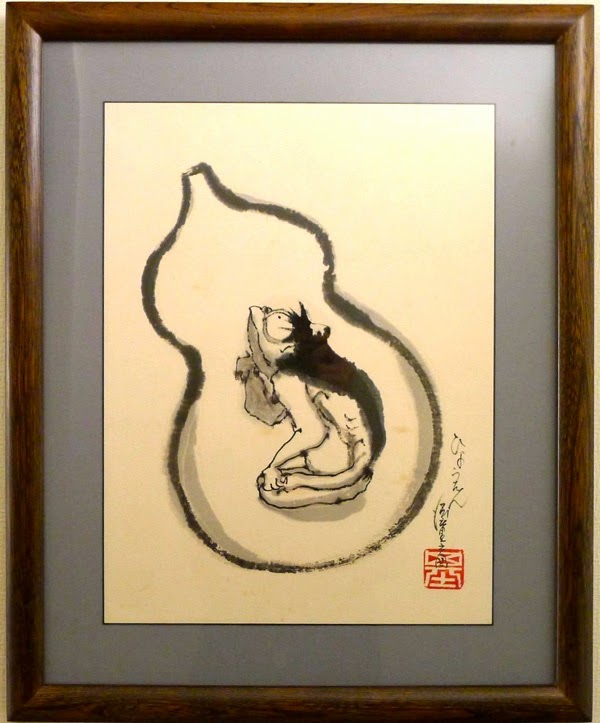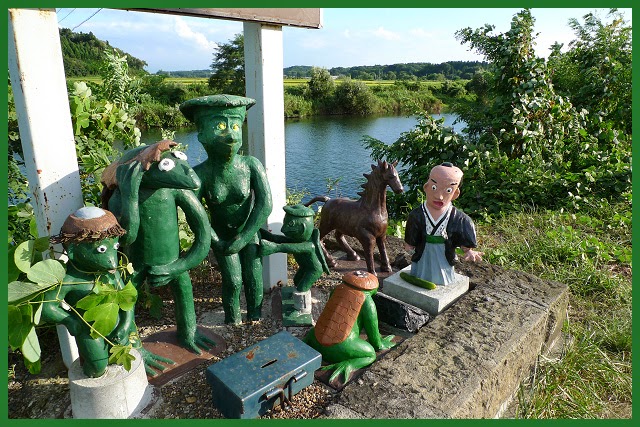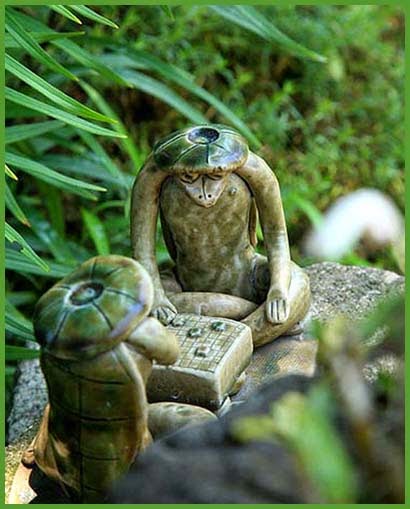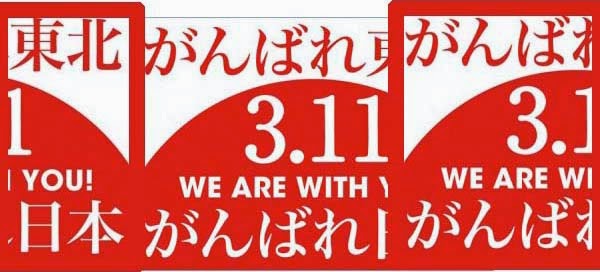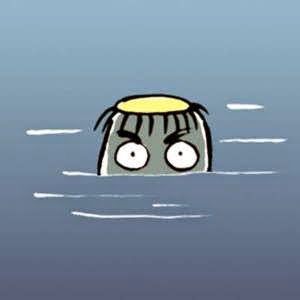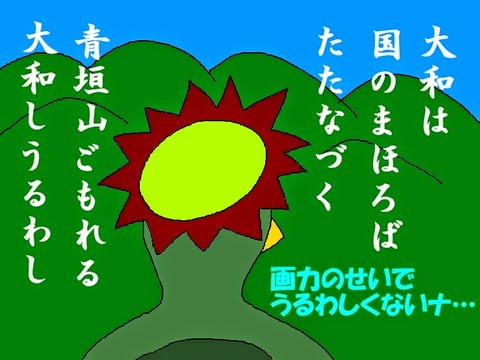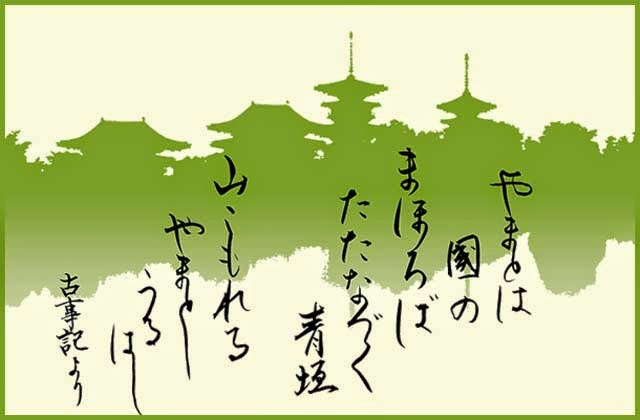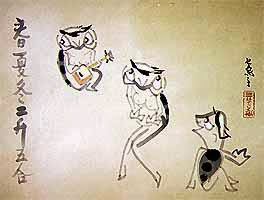:::::::::::::::::::::::::::::::::::::::::::::::::::::::::::::::::::::::::::::::::::::::::::::::::::::::::::::::::::::::::::::::::::::::::::::::::::::::::::::::::::::::::::::::::::
- KAPPA - 河童 / かっぱ / カッパ - Food -
:::::::::::::::::::::::::::::::::::::::::::::::::::::::::::::::::::::::::::::::::::::::::::::::::::::::::::::::::::::::::::::::::::::::::::::::::::::::::::::::::::::::::::::::::::
- kyuuri キュウリ Kyuri, cucumber, Gurken -
The favorite food of a Kappa are cucumbers.
![]()
- quote
Kappa folk also have a liking for cucumbers, a weakness that can be used to human advantage. According to one tale, an offering of cucumbers (on which are etched the name/age of family members) is enough to appease the Kappa, who thereafter will refrain from harming you and your family. Even today, cucumber sushi in Japan is called “Kappa-maki”.
Let us quote Michael Dylan Foster:
“One of the better known of the kappa's traits is its love of kyuri, or cucumbers. Many of the festivals associated with kappa include offerings of cucumbers (e.g., Takeda 1988, and Orikuchi 1955,). Here again, the complexity of the kappa belief is apparent. As Takeda points out, there are some regions where it is believed that eating a cucumber and then swimming will lead to certain attack by a kappa, while in other areas it is a way to ensure protection against attack (Takeda 1988).
Other foods to which the kappa is partial include nasu (Japanese eggplant), soba (buckwheat noodles), natto (fermented soybeans), and kabocha (pumpkin).
Although the kappa is attracted to some foods of the uri, or melon, grouping - such as kyuri and kabocha - it is clear that it has an aversion to hyotan (gourds), which are also of the melon group.
The Nihon shoki passage cited above shows that the power of hyotan to confound the kappa was understood early on.
In one of the folktales involving kappa, the so-called kappa muko, or "kappa bridegroom tale" (Ikeda 1971), the same motif appears. A farmer, whose fields have dried up because of drought, offers his daughter to anybody who can irrigate them. A kappa succeeds in this task and receives the reluctant bride. The daughter, however, challenges the kappa to sink some gourds in the river. The kappa soon exhausts itself trying to complete this impossible task, and abandons the marriage.”
- source : Michael Dylan Foster
![]()
. - hyootan 瓢箪 Hyotan gourd, calabash and Kappa .
:::::::::::::::::::::::::::::::::::::::::::::::::::::::::::::::::::::::::::::::::::::::::::::::::::::::::::::::::::::::::::::::::::::::::::::::::::::::::::::::::::::::::::::::::::
Kappa with cucumber
![]()
- source : umber.deviantart.com
:::::::::::::::::::::::::::::::::::::::::::::::::::::::::::::::::::::::::::::::::::::::::::::::::::::::::::::::::::::::::::::::::::::::::::::::::::::::::::::::::::::::::::::::::::
kappa tsuri, kappatsuri 河童釣 fishing for kappa
is always done with a cucumber.
![]()
source : suuzki GN
Fishing for Kappa is especially popular in Tono, Iwate.
. Tono Monogatari 遠野物語 Legends of Tono, Iwate .
Hokusai has his own version of kappa fishing :
![]()
A man sits above his trap, holding the rope with one hand - and smoking his pipe leisurely.
When the Kappa, lured by the shirikodama anus treasure, comes close, he can capture the Kappa.
『北斎漫画』より「河童を釣るの法」 Hokusai Manga
- source : www.youkaiwiki.com
. - shirikodama . shirigodama 尻子玉 / 尻小玉 "soul ball in the anus" - .
:::::::::::::::::::::::::::::::::::::::::::::::::::::::::::::::::::::::::::::::::::::::::::::::::::::::::::::::::::::::::::::::::::::::::::::::::::::::::::::::::::::::::::::::::::
. - Netsuke with Kappa 河童根付 - .
Kappa - Stealing Cucumber
:::::::::::::::::::::::::::::::::::::::::::::::::::::::::::::::::::::::::::::::::::::::::::::::::::::::::::::::::::::::::::::::::::::::::::::::::::::::::::::::::::::::::::::::::::
Kyuuchan キューちゃん Kyu-Chan - The Town Mascot of Ushiku
"The Cucumber Boy"
![]()
He even gets a birthday cake !
![]()
And Kappa Senbei 河童せんべい are a speciality of the city.
![]()
茨城県牛久市田宮町45-10 ー かっぱ本舗
source : www.kappa-honpo.com
. Ushiku 牛久 Kappa in Ibaraki .
:::::::::::::::::::::::::::::::::::::::::::::::::::::::::::::::::::::::::::::::::::::::::::::::::::::::::::::::::::::::::::::::::::::::::::::::::::::::::::::::::::::::::::::::::::
![]()
Kappa kids nibbeling cucumbers
- source : kizakura facebook 黄桜 カッパ -
:::::::::::::::::::::::::::::::::::::::::::::::::::::::::::::::::::::::::::::::::::::::::::::::::::::::::::::::::::::::::::::::::::::::::::::::::::::::::::::::::::::::::::::::::::
![]()
. . . CLICK here for Japanese Photos !
![]()
. . . CLICK here for "kappa cucumber" Photos !
- reference -
. WKD - kyuuri 胡瓜 (きゅうり) cucumber .
- Introduction -
:::::::::::::::::::::::::::::::::::::::::::::::::::::::::::::::::::::::::::::::::::::::::::::::::::::::::::::::::::::::::::::::::::::::::::::::::::::::::::::::::::::::::::::::::::
![]()
. - - - Join my Kappa friends on facebook ! - - - .
:::::::::::::::::::::::::::::::::::::::::::::::::::::::::::::::::::::::::::::::::::::::::::::::::::::::::::::::::::::::::::::::::::::::::::::::::::::::::::::::::::::::::::::::::::
. Kappa densetsu 河童伝説, Kappa minwa 河童民話 - Legends - Introduction .
. Mingei 民芸 Regional Folk Art from Japan .
- #kappakyuuri #kappacucumber -
:::::::::::::::::::::::::::::::::::::::::::::::::::::::::::::::::::::::::::::::::::::::::::::::::::::::::::::::::::::::::::::::::::::::::::::::::::::::::::::::::::::::::::::::::::
[ . BACK to DARUMA MUSEUM TOP . ]
[ . BACK to WORLDKIGO . TOP . ]
:::::::::::::::::::::::::::::::::::::::::::::::::::::::::::::::::::::::::::::::::::::::::::::::::::::::::::::::::::::::::::::::::::::::::::::::::::::::::::::::::::::::::::::::::::
- KAPPA - 河童 / かっぱ / カッパ - Food -
:::::::::::::::::::::::::::::::::::::::::::::::::::::::::::::::::::::::::::::::::::::::::::::::::::::::::::::::::::::::::::::::::::::::::::::::::::::::::::::::::::::::::::::::::::
- kyuuri キュウリ Kyuri, cucumber, Gurken -
The favorite food of a Kappa are cucumbers.

- quote
Kappa folk also have a liking for cucumbers, a weakness that can be used to human advantage. According to one tale, an offering of cucumbers (on which are etched the name/age of family members) is enough to appease the Kappa, who thereafter will refrain from harming you and your family. Even today, cucumber sushi in Japan is called “Kappa-maki”.
Let us quote Michael Dylan Foster:
“One of the better known of the kappa's traits is its love of kyuri, or cucumbers. Many of the festivals associated with kappa include offerings of cucumbers (e.g., Takeda 1988, and Orikuchi 1955,). Here again, the complexity of the kappa belief is apparent. As Takeda points out, there are some regions where it is believed that eating a cucumber and then swimming will lead to certain attack by a kappa, while in other areas it is a way to ensure protection against attack (Takeda 1988).
Other foods to which the kappa is partial include nasu (Japanese eggplant), soba (buckwheat noodles), natto (fermented soybeans), and kabocha (pumpkin).
Although the kappa is attracted to some foods of the uri, or melon, grouping - such as kyuri and kabocha - it is clear that it has an aversion to hyotan (gourds), which are also of the melon group.
The Nihon shoki passage cited above shows that the power of hyotan to confound the kappa was understood early on.
In one of the folktales involving kappa, the so-called kappa muko, or "kappa bridegroom tale" (Ikeda 1971), the same motif appears. A farmer, whose fields have dried up because of drought, offers his daughter to anybody who can irrigate them. A kappa succeeds in this task and receives the reluctant bride. The daughter, however, challenges the kappa to sink some gourds in the river. The kappa soon exhausts itself trying to complete this impossible task, and abandons the marriage.”
- source : Michael Dylan Foster

. - hyootan 瓢箪 Hyotan gourd, calabash and Kappa .
:::::::::::::::::::::::::::::::::::::::::::::::::::::::::::::::::::::::::::::::::::::::::::::::::::::::::::::::::::::::::::::::::::::::::::::::::::::::::::::::::::::::::::::::::::
Kappa with cucumber

- source : umber.deviantart.com
:::::::::::::::::::::::::::::::::::::::::::::::::::::::::::::::::::::::::::::::::::::::::::::::::::::::::::::::::::::::::::::::::::::::::::::::::::::::::::::::::::::::::::::::::::
kappa tsuri, kappatsuri 河童釣 fishing for kappa
is always done with a cucumber.
source : suuzki GN
Fishing for Kappa is especially popular in Tono, Iwate.
. Tono Monogatari 遠野物語 Legends of Tono, Iwate .
Hokusai has his own version of kappa fishing :

A man sits above his trap, holding the rope with one hand - and smoking his pipe leisurely.
When the Kappa, lured by the shirikodama anus treasure, comes close, he can capture the Kappa.
『北斎漫画』より「河童を釣るの法」 Hokusai Manga
- source : www.youkaiwiki.com
. - shirikodama . shirigodama 尻子玉 / 尻小玉 "soul ball in the anus" - .
:::::::::::::::::::::::::::::::::::::::::::::::::::::::::::::::::::::::::::::::::::::::::::::::::::::::::::::::::::::::::::::::::::::::::::::::::::::::::::::::::::::::::::::::::::
. - Netsuke with Kappa 河童根付 - .
Kappa - Stealing Cucumber
:::::::::::::::::::::::::::::::::::::::::::::::::::::::::::::::::::::::::::::::::::::::::::::::::::::::::::::::::::::::::::::::::::::::::::::::::::::::::::::::::::::::::::::::::::
Kyuuchan キューちゃん Kyu-Chan - The Town Mascot of Ushiku
"The Cucumber Boy"
He even gets a birthday cake !

And Kappa Senbei 河童せんべい are a speciality of the city.

茨城県牛久市田宮町45-10 ー かっぱ本舗
source : www.kappa-honpo.com
. Ushiku 牛久 Kappa in Ibaraki .
:::::::::::::::::::::::::::::::::::::::::::::::::::::::::::::::::::::::::::::::::::::::::::::::::::::::::::::::::::::::::::::::::::::::::::::::::::::::::::::::::::::::::::::::::::

Kappa kids nibbeling cucumbers
- source : kizakura facebook 黄桜 カッパ -
:::::::::::::::::::::::::::::::::::::::::::::::::::::::::::::::::::::::::::::::::::::::::::::::::::::::::::::::::::::::::::::::::::::::::::::::::::::::::::::::::::::::::::::::::::
. . . CLICK here for Japanese Photos !

. . . CLICK here for "kappa cucumber" Photos !
- reference -
. WKD - kyuuri 胡瓜 (きゅうり) cucumber .
- Introduction -
:::::::::::::::::::::::::::::::::::::::::::::::::::::::::::::::::::::::::::::::::::::::::::::::::::::::::::::::::::::::::::::::::::::::::::::::::::::::::::::::::::::::::::::::::::

. - - - Join my Kappa friends on facebook ! - - - .
:::::::::::::::::::::::::::::::::::::::::::::::::::::::::::::::::::::::::::::::::::::::::::::::::::::::::::::::::::::::::::::::::::::::::::::::::::::::::::::::::::::::::::::::::::
. Kappa densetsu 河童伝説, Kappa minwa 河童民話 - Legends - Introduction .
. Mingei 民芸 Regional Folk Art from Japan .
- #kappakyuuri #kappacucumber -
:::::::::::::::::::::::::::::::::::::::::::::::::::::::::::::::::::::::::::::::::::::::::::::::::::::::::::::::::::::::::::::::::::::::::::::::::::::::::::::::::::::::::::::::::::
[ . BACK to DARUMA MUSEUM TOP . ]
[ . BACK to WORLDKIGO . TOP . ]
:::::::::::::::::::::::::::::::::::::::::::::::::::::::::::::::::::::::::::::::::::::::::::::::::::::::::::::::::::::::::::::::::::::::::::::::::::::::::::::::::::::::::::::::::::
